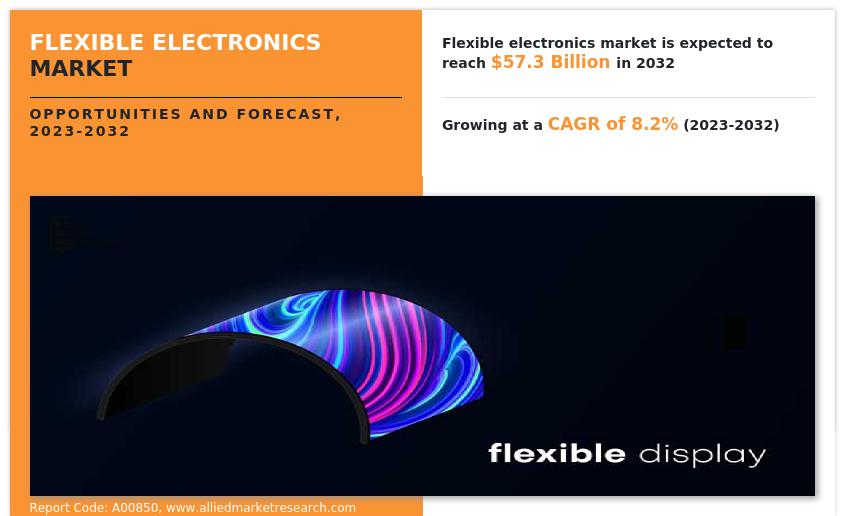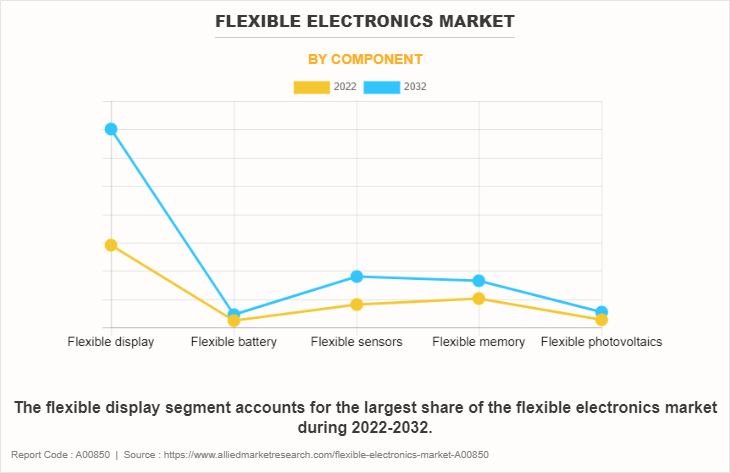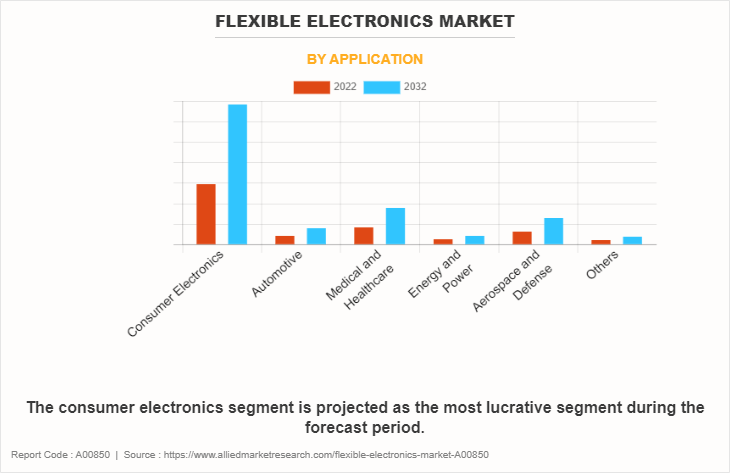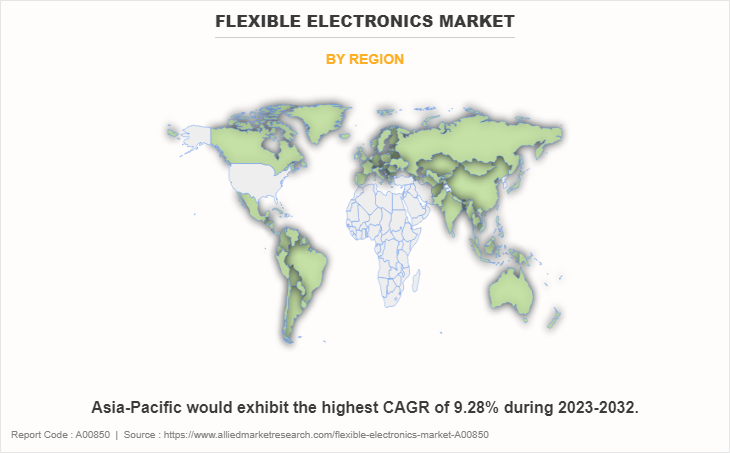Flexible Electronics Market Research, 2032
The Global Flexible Electronics Market was valued at $26.2 billion in 2022 and is projected to reach $57.3 billion by 2032, growing at a CAGR of 8.2% from 2023 to 2032. Flexible electronics are composed of a bilayer of thin passive substrate topped with a second layer of active electronic components, enabling bends, rolls, folds, and stretches without hampering their performance. Generally, flexible electronic components are made up of a substrate, backplane, front plane, and encapsulation. The flexible electronic capability is incorporated into different consumer and industrial products using the conformability offered by the components to get shaped into various shapes. Furthermore, the integration of data analytics and artificial intelligence with flexible electronics enhances digital intelligence rapidly.

Segment Overview
The flexible electronics market is segmented into components and applications
The market is expected to witness growth during the forecast period due to growth in sales of Internet of Things (IoT) devices and an increase in government concern of governmentconcern for flexible electronics. Furthermore, a rise in demand for portable and smart electronics products is expected to drive the market growth. Moreover, growth in printed electronics further accelerates the flexible electronics growth projections, creating lucrative opportunities for various applications. Considering these factors, it is estimated that the flexible electronics market will experience steep growth shortly.'
In flexible electronics market segmentation, based on components, the market is divided into flexible displays, flexible batteries, flexible sensors, flexible memories, and flexible photovoltaics. Among these, the flexible display segment took the lead in the global market in 2022. This dominance is attributed to its ability to facilitate the development of smaller, lighter, and more durable portable devices, all while integrating advanced display technology.

Based on applications, the flexible electronics industry is divided into consumer electronics, automotive, medical & healthcare, energy & power, aerospace & defense, and others. The consumer electronics segment accounted for the highest flexible electronics market share in 2022, owing to the widespread adoption of wearable devices, smart electronics, and investments in flexible display technologies by leading market players.

Based on region, the global flexible electronics market is analyzed across North America (the U.S., Canada, and Mexico), Europe (the UK, Germany, France, Italy, and the rest of Europe), Asia-Pacific (China, India, Japan, South Korea, and rest of Asia-Pacific), Latin America (Brazil, Chile, and Argentina), and Middle East & Africa (UAE, Saudi Arabia, and Africa). Asia-Pacific accounted for the largest share, primarily due to robust technological advancements and the growing demand for consumer electronics in the region.

Country-wise, the U.S. is the highest revenue generator in the flexible electronics market in North America due to several factors. The region is home to many leading technology companies and startups, fostering innovation and development in flexible electronics. Additionally, the U.S. has a strong consumer electronics market and a well-established healthcare sector, both of which extensively utilize flexible electronics. The presence of advanced research facilities and significant investment in R&D also contributes to its leading position in this market. In market size by country, this statement encapsulates the prominence of the U.S. within the broader North American flexible electronics market.
In Europe, the 'Rest of Europe' region, excluding major economies like Germany, France, and the UK, emerges as a top revenue generator. This is due to the presence of several emerging economies that are rapidly adopting modern technologies. The region benefits from EU funding for technological advancements and has seen increased investment in sectors like automotive and consumer electronics, where flexible electronics are increasingly used.
China's dominance in the Asia-Pacific flexible electronics industry can be attributed to its massive manufacturing base and global leadership in electronics production. The country's substantial investments in technology and innovation, coupled with its large consumer base, drive demand for flexible electronics. Furthermore, government initiatives supporting the electronics industry and the presence of major manufacturing hubs significantly contribute to its leading revenue position.
In Latin America, Brazil leads in generating revenue from flexible electronics. This can be attributed to its large and growing consumer market, which has an increasing demand for advanced electronics, including wearable devices and smart gadgets. Additionally, Brazil's efforts to modernize its healthcare and automotive sectors play a crucial role in adopting flexible electronics technologies.
Saudi Arabia is the top revenue generator in the Middle East and Africa region for flexible electronics. The country's economic diversification efforts away from oil, particularly into technology and industrial sectors, have played a key role. Investment in infrastructure development and the adoption of modern technologies in various sectors, including consumer electronics and healthcare, are significant contributors to Saudi Arabia's leading position in the market.
The flexible electronics market is estimated to revolutionize displays, lighting technology, grid connection, power integration, health monitoring systems, and others. It also plays a vital role in the development of smart cities and connected infrastructure. These applications further fuel the market growth during the forecast period. Flex circuits are revolutionizing the electronics industry with their adaptability and durability, paving the way for innovative bendable electronics. The unique properties of flex circuits allow for the creation of flex PCB designs that are not only space-efficient but also capable of withstanding the rigors of dynamic applications, marking a significant advancement in the field of flexible technology.
Furthermore, technological advancements in flexible electronics are estimated to create lucrative opportunities for the industry. As research and development continue to progress, new methods and materials are being discovered that enhance the performance, durability, and versatility of flexible electronics. These improvements can lead to the creation of more efficient, thinner, and more reliable flexible electronic components. Such advancements not only expand the potential applications of flexible electronics in various sectors, including healthcare, consumer electronics, and automotive industries, but also help in reducing manufacturing costs over time. As the technology becomes more accessible and applicable to a wider range of products, it opens up significant flexible electronics market opportunities, attracting investment and driving industry growth. This evolution of flexible electronics technology is anticipated to generate substantial revenue streams for companies involved in this field.
Top Impacting Factors
The significant impacting factors in the flexible electronics market include the rise in the Internet of Things (IoT), the increase in the adoption of portable and smart electronics, and the rise in investments in developing flexible electronics. However, cost constraint is expected to hinder market growth. Conversely, the introduction of flexible electronics to new applications is projected to offer remunerative opportunities to the market. Each of these factors is anticipated to have a definite impact on the market during the forecast period.
Competitive Analysis
The flexible electronics market report highlights the highly competitive nature of the flexible electronics market, owing to the strong presence of existing vendors. Vendors with extensive technical and financial resources are expected to gain a competitive advantage over their counterparts by effectively addressing market demands. The competitive environment in this market is expected to increase as the product launch kind of strategy adopted by key vendors increases. Competitive analysis and profiles of the flexible electronics market players that have been provided in the report include Samsung Electronics Co. Ltd., Palo Alto Research Center Incorporated, Solar Frontier, Enfucell SoftBattery, Cymbet Corporation, Blue Spark Technologies, E Ink Holdings Inc., Imprint Energy Inc., LG Electronics, and AU Optronics Corp. In the flexible electronics market share by company, Samsung Electronics Co. Ltd. stands out as a key contributor, underlining its strong foothold in the flexible electronics industry.
Key Developments / Strategies
According to the latest flexible electronics market overview, Samsung Electronics Co. Ltd., LG Electronics, AU Optronics Corp., E Ink Holdings Inc., and Cymbet Corporation are the top 5 flexible electronics companies in the market. Top market players have adopted a product launch strategy to expand their foothold in the market.
- May 2023 - Samsung has unveiled its future foldable display concepts, including a double-folding OLED panel with a 7.2-inch screen, a slidable OLED display, and a 17-inch foldable panel for a potential Galaxy tablet. Additionally, Samsung showcased an under-panel camera (UPC) display in a concept notebook, aiming for edge-to-edge panels. These innovations demonstrate Samsung's commitment to staying at the forefront of foldable technology amid growing competition in the industry.
- November 2023 - Japanese CIS thin-film PV module manufacturer, Solar Frontier, has abandoned thin-film production and launched its first monocrystalline solar panel, the SFB250-88A, with a 250 W capacity for the residential market. This move is part of the company's shift to become a PV system provider and OEM panel manufacturer. The new panel offers a 22% higher yield compared to its previous CIS modules and comes with a 20-year performance guarantee.
Key Benefits for Stakeholders
- To provide an accurate view of future investment pockets, this study provides analytical estimates for the flexible electronics market size along with current trends and estimations.
- In order to be able to achieve a more prominent position, the overall market analysis is based on an understanding of prevailing profitability trends.
- The report presents information related to key drivers, restraints, and market opportunities with a detailed impact analysis.
- To measure financial competence, flexible electronics market forecasts shall be quantitatively analyzed from 2022 to 2032.
- The Porter Five Forces analysis shows that buyers and suppliers are more powerful in the market.
- Key vendor shares and flexible electronics market trends are included in the report.
Flexible Electronics Market, by Application Report Highlights
| Aspects | Details |
| Market Size By 2032 | USD 57.3 billion |
| Growth Rate | CAGR of 8.2% |
| Forecast period | 2022 - 2032 |
| Report Pages | 256 |
| By Application |
|
| By Component |
|
| By Region |
|
| Key Market Players | Cymbet Corporation, Samsung Electronics Co. Ltd., Imprint Energy Inc., Solar Frontier, AU Optronics Corp., Blue Spark Technologies, Inc., Palo Alto Research Center Incorporated, LG Electronics, Enfucell SoftBattery, E Ink Holdings Inc. |
Analyst Review
Flexible electronics is anticipated to revolutionize the comprehensive and highly vertical microelectronics industry supply chain, yielding enormous business opportunities in various applications. Flexible electronics has an impressive ability to integrate with various next-generation technologies such as big data analytics and artificial intelligence to develop new products for consumers. Rather than competing with conventional electronics in terms of performance and computing power, flexible electronics offers innovative ways to interact with environments that were not possible before.
Flexible electronics is estimated to evolve continuously, driven by research in functional materials with incredible form factors and new methodologies for fabricating devices in unconventional shapes, in faster, cheaper, and more accessible manners. However, the flexible electronics market is estimated to progress by delivering end products with improved durability, stability, and reliability in terms of device functionalities. With technological advancements, it is anticipated to overcome manufacturing barriers, including the adaptation of equipment to work with developed materials and inks, to balance the initial low yield rates of new technologies with proposed investments.
Various leading manufacturers such as Samsung Electronics Co., Ltd., Solar Frontier, Palo Alto Research Center Incorporated, LG Corporation, Cymbet Corporation, Blue Spark Technologies, Enfucell Flexible Electronics Co., Ltd., Imprint Energy, E Ink Holdings, and AU Optronics occupy a prominent revenue share in the flexible electronics market.
The industry size of Flexible Electronics is estimated to be $26,226.9 million in 2022.
The Flexible Electronics Market is expected to grow at a CAGR of 8.21% during the period of 2023 to 2032.
Asia-Pacific is the largest regional market for Flexible Electronics.
Consumer electronics is the leading application of the Flexible Electronics Market.
The top companies holding significant market share in the Flexible Electronics industry include Samsung Electronics Co. Ltd., LG Electronics, AU Optronics Corp., E Ink Holdings Inc., and Cymbet Corporation.
Loading Table Of Content...
Loading Research Methodology...



